PRINCETON, NJ -- As the general election campaign between Barack Obama and John McCain unofficially gets underway, many of the typical Democratic-Republican divides in the electorate -- such as those by religion, gender, marital status, and income -- already appear to be in place. Additionally, some of the special appeals each candidate had with voters in the nomination phase of the election (on the basis of age, education, race, and political affiliation) seem to be carrying over into the general election.
These findings are based on aggregated data from ������ Poll Daily tracking in May, consisting of more than 25,000 total interviews with registered voters nationwide. Obama (supported by an average of 45.6% of national registered voters) and McCain (favored by 45.4%) were essentially tied in the full May dataset.
Gender
As is typically the case in U.S. presidential elections, the Republican candidate is running better among male voters, while the Democrat fares better among women. The data show McCain with a six-point advantage over Obama among men, and Obama leading McCain by the same margin among women.
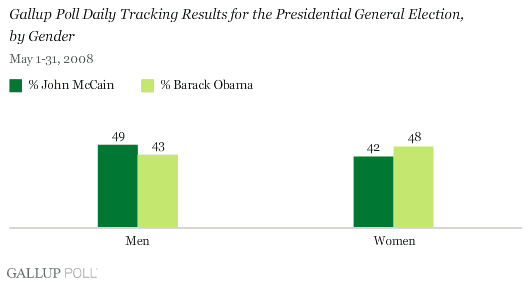
Age
Perhaps one of the greatest divides in the 2008 election will be along age lines, with Obama demonstrating great appeal to younger voters, but not faring as well among senior citizens. Obama leads McCain by 23 points among voters aged 18 to 29, while trailing McCain by 12 points among those 65 and older. The two run about evenly among the two middle age groups.
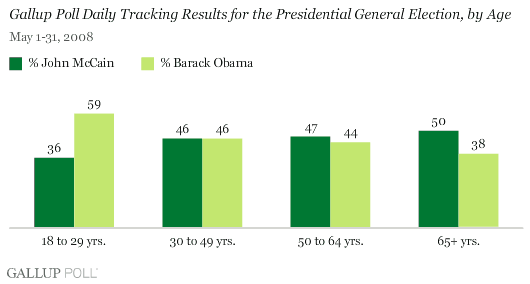
Race
It's no secret that Obama owes his nomination in large part to overwhelming support among blacks, and that high level of support will likely be evident in the general election. Roughly 9 in 10 blacks say they would vote for Obama if the election were held today, while McCain's support among blacks is in the low single digits. Blacks are typically a strong Democratic constituency, so the impact of the first black presidential candidate on a major-party ticket may be more evident in terms of motivating high black turnout than in overwhelming support for the Democrat.
Obama did not fare well against Hillary Clinton among Hispanics in the 2008 primaries, but the early indications are that he will do well among this increasingly Democratic group in the general election. The May data show Obama with a 62% to 29% advantage over McCain among Hispanics.
McCain currently maintains a strong advantage over Obama among non-Hispanic white voters, 53% to 38%.
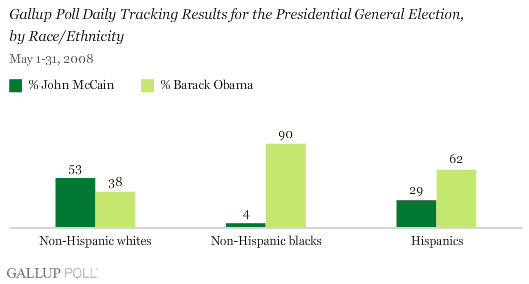
Education
Highly educated voters were another key group helping to propel Obama to the Democratic nomination. The two candidates run about evenly among all education groups except those with postgraduate educations, among whom Obama currently leads by a significant margin. It is notable that McCain runs competitively with Obama among voters with a high-school education or less, which is normally a solid Democratic group. Obama offsets that by running evenly with McCain in a usually strong Republican group -- voters with a four-year degree but no postgraduate education.
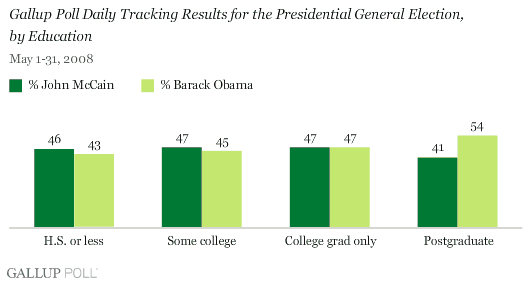
Income
While Obama does not fare as well among the traditional Democratic group of lower-education voters, he does do well among the usually Democratic group of lower-income voters, beating McCain by double digits among this group. The two are competitive among middle- and upper-income voters, with McCain doing slightly better among wealthier voters.
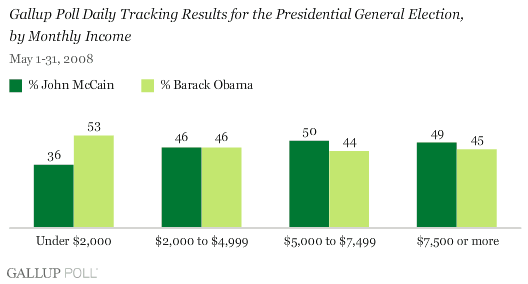
Region
McCain -- like Republican candidates before him -- is the heavy favorite in the South. Obama leads McCain in the East and West. The Midwest may be the most competitive region this election, with Obama currently maintaining a slight advantage in his home region.
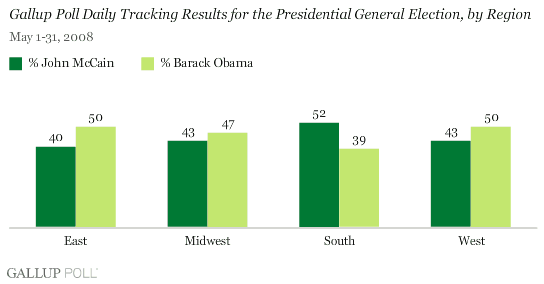
Party Identification
Both McCain and Obama can thank independents for helping them gain their respective parties' presidential nomination. And the two candidates are closely matched among independents for the general election.
In terms of the two major political party groups, McCain is securing greater party loyalty at the moment, holding 85% of his fellow Republicans compared with 76% support for Obama among Democrats. But because at this point in the campaign, more Americans identify themselves as Democrats than as Republicans, it is more critical to McCain's fortunes to hold his base than it is for Obama.
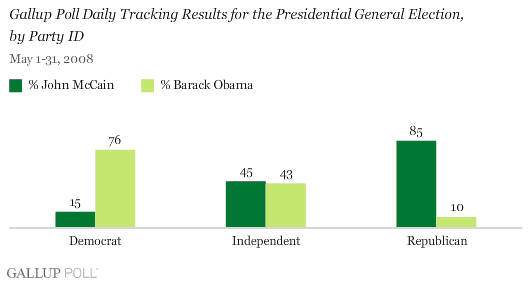
Ideology
Liberals overwhelmingly support Obama, with 8 in 10 saying they would vote for him. McCain gets the support of 69% of conservatives. Again, because more Americans identify themselves as conservatives than as liberals, Obama needs to keep his fellow ideologues in the fold more than McCain does. Obama leads McCain among political moderates, 50% to 38%.
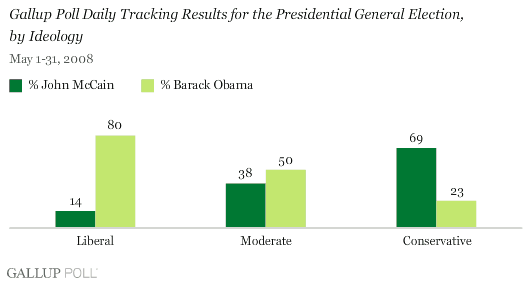
Religiosity
Religious commitment has proven to be one of the greatest dividing lines in U.S. politics, with highly religious voters aligning themselves with the Republican Party and nonreligious voters tending to vote Democratic. Those patterns are apparent in the 2008 campaign, with McCain holding a 19-point lead among voters who attend religious services weekly, and Obama leading by 16 points among those who rarely or never attend church. The two candidates are evenly matched among the middle group that attends church on an irregular basis.
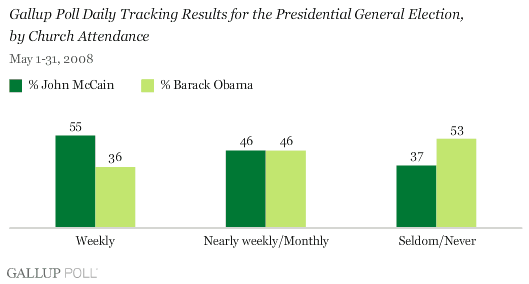
Religious Preference
McCain leads Obama by 10 points among Protestants and other non-Catholic Christians, the largest religious group in the United States. McCain's lead would be even larger except for the facts that blacks are most likely to be Protestant and overwhelmingly support Obama. Catholics are a traditional swing group, and McCain and Obama are evenly matched among them at this point. Obama has a significant lead among two reliably Democratic groups -- Jewish voters and voters with no religious affiliation.
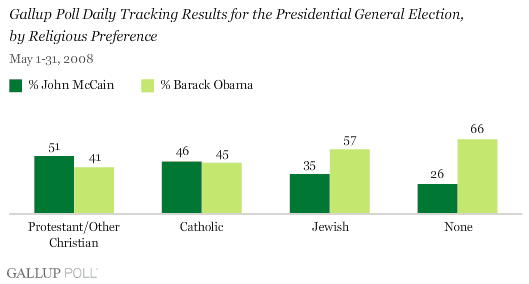
Marital Status
In recent presidential elections, married voters have tended to vote Republican, and unmarried voters Democratic. That relationship appears as if it will hold in 2008, with McCain up by 13 points over Obama among those currently married, while Obama has a 20-point lead among those who are not married.
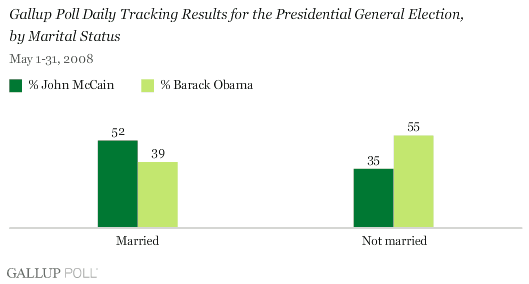
Red vs. Blue States
The candidates will likely use the electoral map of 2004 as a starting point to plan their campaign strategies for 2008. As of now, both candidates are running strongly among voters in states their respective parties won by comfortable margins in 2004. Obama currently holds a slim advantage among voters in the swing states -- those where the winning candidate won a narrow victory of five percentage points or less.
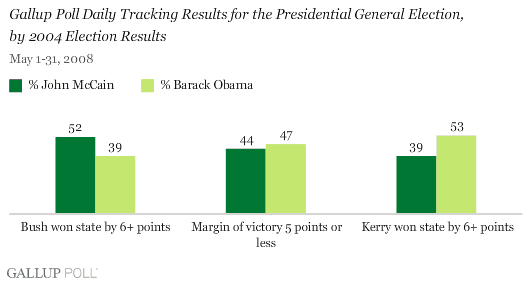
Survey Methods
Results are based on telephone interviews with 25,512 registered voters, aged 18 and older, conducted May 1-31, 2008, as part of ������ Poll Daily tracking. For results based on the total sample of registered voters, one can say with 95% confidence that the maximum margin of sampling error is ±1 percentage points.
Margins of error for subgroups are larger.
Interviews are conducted with respondents on land-line telephones (for respondents with a land-line telephone) and cellular phones (for respondents who are cell-phone only).
In addition to sampling error, question wording and practical difficulties in conducting surveys can introduce error or bias into the findings of public opinion polls.
To provide feedback or suggestions about how to improve ������.com, please e-mail feedback@gallup.com.
